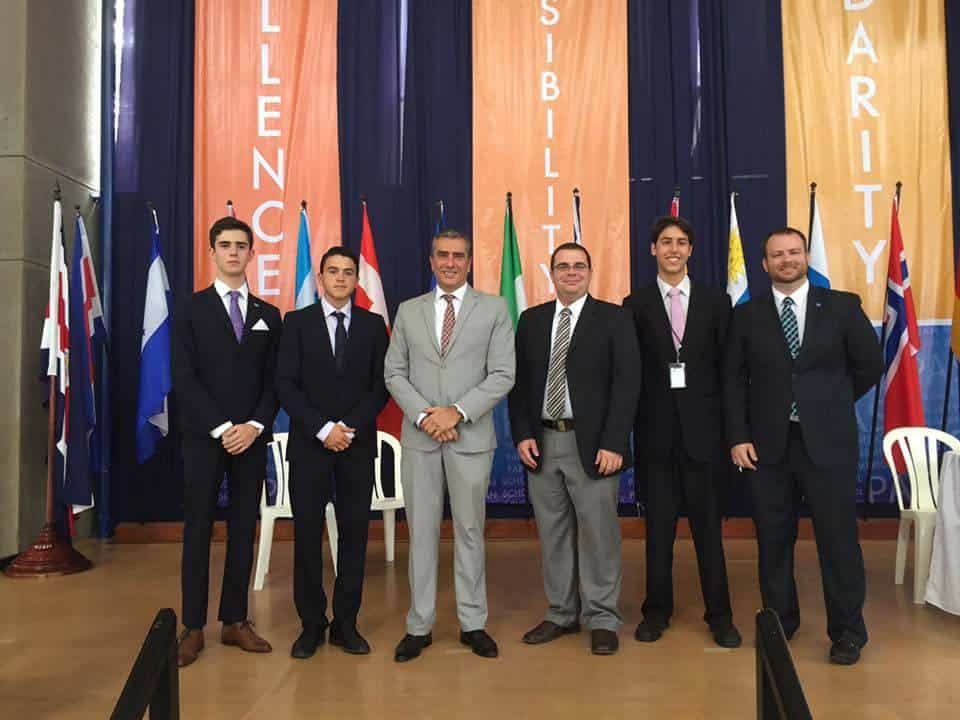Editor’s Note: In honor of The Tico Times’ roots as a local paper that first emerged from the classrooms of San José’s Lincoln School, we will be publishing a series of articles that highlight the country’s international schools and their effect on the broader community. For more information or to suggest topics we should explore, please write to mkrumholtz@ticotimes.net.
Patrick Miller, the secondary school director at Pan-American, likes to make sure each one of his students has the opportunity to follow his or her passion.
Pan-American is a bilingual private school that offers every level from preschool to 12th grade on its campus in San Antonio de Belén, Heredia. With just over 600 students from 29 different countries, the small but diverse student body is encouraged to get involved early and often thanks to programs that Miller and other faculty members have helped initiate. Their strong offering of self-funded community programs allow the students to give back through domestic and international causes and international ones. Among his many roles as director, Miller helps lead volunteer programs at the school, such as regular trips to Haiti for aid work.
“We’re a large enough school to create lots of opportunities for the kids, but we’re small enough that we’re able to meet the individual needs of the students,” Miller said. “So we really try to get each kid plugged into something, whether that’s Model United Nations, the soccer team, the global issues network, or any area that that kid is passionate about.”
The Tico Times sat down with Miller, 31, who is originally from Kentucky and has spent the past decade in teaching and administration roles at Costa Rican schools. Miller begins our series taking a look inside international schools and their community endeavors. Excerpts follow.
What was it that attracted you to Costa Rica?
It’s always warm, so the weather was definitely a big pull, especially after dealing with U.S. winters. I think the laid-back lifestyle as compared to working in the U.S. It’s just a different pace of life and way of life, which I think is important.
When you first came through the doors of Pan-American, what were some of the obstacles you saw? And fast-forward six years: what has transformed about the school?
Pan-American was going through a really important change process. The school has been accredited by a U.S. accrediting association called NEASC (New England Association of Schools and Colleges) for 10 years. One of the things that we’ve been doing is trying to make the program more international, so we implemented the International Baccalaureate Diploma Program (IBDP), which was a big challenge because it meant a change in school culture as well. We changed calendars, so now we’re on a U.S. calendar. I think that school functioning and logistics [was the] more than anything cultural.
You mentioned the IBDP. What exactly does that entail?
The International Baccalaureate Diploma Program originated in Switzerland and is a common framework of education for international schools to use. It results in a diploma where they take courses in six different subjects and three core areas from the program. They have international exams at the end of the two-year instructional process. They pass those international exams and get the IBDP.
Have volunteer programs like the trip to Haiti been part of a larger initiative from you?
The school has always had a service program, and it’s always been a values-first education. With the implementation of the IBDP, we’ve really stepped up our game. One of the things that we focus on is that our students are really privileged to get the kind of education that they get, so it’s their responsibility to use that education to give back to the community. We really instill that in them so that when they’re out in the business world they’ll always have in the back of their mind, “I’m here because I was privileged… Now it’s time to turn around and hand it off to someone else and give back.”
Sometimes in Costa Rica, people who look at kids in this school and may think, “Those are just spoiled, rich kids.” With these community programs, you can really get the kids on the ground and involved. Is part of the emphasis trying to erode reputations or assumptions?
It’s not about reputation. I think of the old saying, “Actions speak louder than words.” The school can have the reputation it wants to have, but what is more important to us is the formation that we’re giving to our students and graduates. Kids in our schools and any similar schools live in a bubble. Our objective is to break that bubble in as many ways as we possibly can. Their adult life is not going to be in a bubble, so we really need to prepare them for the realities of the world they’re going to face once they graduate from our school.
Domestically, what are you focusing on in terms of volunteer programs?
Our middle school program works with a whole group of public schools. We work with homes for the elderly. A food bank. Everything from cleaning beaches to improving trails. Sea turtles. We have a fully structured curriculum about community projects, so we’re teaching them how to build these projects on the logistical side of things. And they fully fund themselves. Our students raise the funds for the projects that they’re going to implement, so they work through all of those life skills that you get by planning events and activities and service. Then they go three times a year to the same place. We give them the full gamut of activities that they can do through the curriculum and the skills that they need to develop the projects.
How many of your graduates go on to U.S. universities each year?
Some of them get scholarships. About two-thirds will end up at universities outside of the country, most of those being in the United States, some back in their home countries or in European schools. A lot of those who stay do so because they are studying law or medicine, or something that is more convenient to study here because of the way professional degrees are set up.
For anyone coming down to work in Costa Rica, there can be some frustrating cultural hurdles. Was there any frustration regarding administering education here for you?
I think one of the first things I had to really realize is that I’m the outsider, so there are certain things that I am going to bring in new to the table that are different than how things are done. But then there are certain things that are instilled in the culture and not going to change, so I am going to have to change my approach as well. The U.S. tends to be a very task-oriented culture. Latin Americans, especially Costa Ricans, have a very people-oriented culture. So whenever it comes to a school or business or anything else, you have to really focus on those relationships with the people that make up the organization and not just the job that you have to get done at the end of the day.
How would you say that you’ve modeled your administration plan for the school?
We get our kids plugged into something that’s going to make them passionate about coming into school. We have a fitness program in the morning. At 7:30 to 8:15 a.m. the whole school exercises before they start [classes]. What we found out is that our kids are happy because they’re plugged into some activity, they’re healthy because they’re doing physical exercise. Then with the IBDP program, we’ll offer such a broad menu of courses that we’re also able to tailor their course selection to their own academic needs by some of their strengths and weaknesses. There’s not really any good reason for a student not to find his or her niche in our school.







